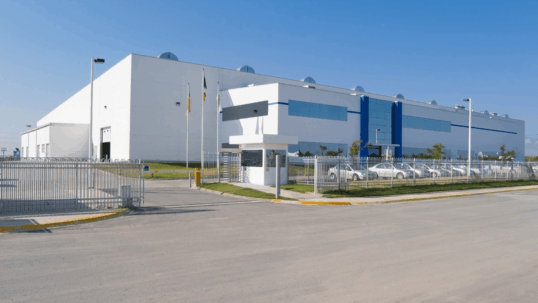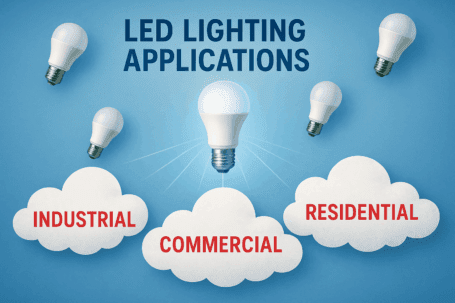The type of lighting you select for your grocery store is important. When food looks attractive and appetizing, shoppers want to buy them. When you have the best lighting possible, you can save energy and money, and in addition provide your customers with an enjoyable shopping experience.
There are many grocery stores across the United States that are seeing the benefits of LED lighting. LED lights attract customers, and make the food look more appetizing and appealing to them. For example, the LED lights can make fruits and vegetables look fresh, as well as make the frozen foods boxes and labels stand out. While you may be wondering how that is possible, LED lights cast a different sort of lighting and when it comes to showcasing food, many believe it makes food look more appealing.
Changing your grocery store lighting will not only make the food look better, but you can save money. LED lighting can cut energy costs because they do not use a lot of power. Your favorite green vegetables and bright fruits will appeal to your customers, and show them how much your store cares about quality.
When food looks attractive and appetizing, shoppers want to buy them. When you have the best lighting possible, you can save energy and money, and in addition provide your customers with an enjoyable shopping experience.
Merchandising That Sells: Color, Brightness, and Comfort
Offers Exceptional Coloring
Meats — Although sliced meats that look discolored may only be an aesthetic concern, it can turn off shoppers from buying. When you use LED lighting, you don’t have to worry about meat discoloration.
Produce — Fruits and vegetables look better under LED lighting. To draw additional attention on certain types of produce, use special optics that can enhance the color spectrum of fresh foods even more.
Dairy, bakery, frozen — LEDs make frozen foods boxes and labels stand out and help bakery and dairy counters look crisp without adding heat.
LEDs Are Bright — and Easy on the Eyes
In a grocery store, you don’t need mood lighting. You need bright lighting, which makes it easy for customers to see what they’re looking at. Plus, it should also be bright enough to read the labels on products. Fortunately, LED lights are quite bright and can increase the quality of the customer’s shopping experience. Even though it’s necessary for a customer to be able to see everything clearly, they don’t want something that’s going to hurt their eyes. LEDs mimic natural daylight, making them easier on the eyes. This will encourage customers to continue shopping.
Use Daylight Where It Matters
If your store lacks natural lighting, you can use LEDs with daylight‑level lumens to illuminate the organic and fresh food sections. It lights up the food without exposing it to extra heat, and the look of natural lighting underlines the message of natural foods, resulting in better sales.
Color Quality Basics: CCT and CRI
Choose your lights according to Correlated Color Temperature (CCT) and Color Rendering Index (CRI).
- CCT can be cool (makes your store feel bigger), neutral (promotes a feeling of well‑being), or warm (more homey). Different lighting works well in different areas, even side by side, to create different feelings and highlight different products.
- CRI measures how a light source renders the colors of lighted products. Color Rendering Index is measured on a 0–100 scale, and using lights with a CRI between 80 and 100 is best for a grocery because it makes colors look vivid and natural. Lighting the produce section with lights that have a poor CRI makes the produce look less well‑grown or healthy.
Tip: If you want to emphasize a new organic display, placing lights with an even higher CRI than in the surrounding displays can make organic produce look even healthier and more nutritious.
Create Experiences That Compete with Online
The battle between physical stores and online retailers will persist for years. Physical stores still control a significant portion of the market, and this trend is expected to continue as shoppers seek a comprehensive shopping experience, rather than just efficient purchasing. Lighting plays a large part of how shoppers feel in your store, so improve your lighting with these changes:
- Have warm, low lighting that allows shoppers to congregate. In‑store coffee shops, delis and eateries give your customers a place to relax before or after shopping. Make the spaces feel warm and homey with warm lighting, and light the tables with individual fixtures under general lighting so the space doesn’t feel industrial.
- Use accent lighting to emphasize free samples. Add free samples near your bakery and deli so customers can sample and experience the featured products. Accent lighting helps draw customers in and directs traffic so they feel more implicitly invited to try the samples.
- Use daylight bulbs to replicate sunlight near organic and fresh foods. The look of natural lighting underlines the message of natural foods.
The Four Layers of Grocery Lighting
Grocery stores are split into sections, and lighting does a lot of the heavy lifting.
- General (ambient) lighting sets the baseline across the sales floor.
- Task lighting is restricted to work‑based areas such as customer service desks, check‑out registers, and back storage areas. This lighting is brighter and creates more contrast so employees can better process payments and provide services.
- Accent lighting should be precise and intense, almost like a spotlight on goods you want customers to focus on. To make accent lighting eye‑catching, don’t light more than 20% of an area, and give each accent a specific purpose.
- Decorative lighting adds warmth, color, and visual breaks for boutique areas like in‑store coffee shops or third‑party bakeries.
Lighting your grocery store appropriately can help encourage customers to purchase produce and perishable goods, as well as select goods of focus. It also helps your employees perform better at their jobs without creating abrasive lighting across the store.
Cold Cases, Freezers, and Refrigeration: Light Without Heat
Most of your grocery store’s energy use is probably on refrigeration. The majority of the use is toward refrigerator cases, freezers, and soda cases near the checkout counters. When you add LED lighting to your refrigerator display cases and freezers, you gain:
- Reduction on energy costs: The systems in LED lighting will not emit an excess amount of heat, so the compressor does not have to do so much work. The LED cases will perform at low temperatures.
- Reduction on maintenance costs: LED lights have a longer useful life than fluorescent lights, resulting in decreased maintenance.
- Environmentally‑friendly operation: LED lighting does not contain mercury. The low consumption of energy will not have any gas emissions.
Although fluorescent lighting may be an efficient way for many applications, it’s not as effective as LED lighting when it comes to freezer and refrigerator lighting. Cold temperatures can cause a drop in the mercury vapor pressure inside fluorescent lamps, resulting in a light output reduction of as much as 25 percent. On the other hand, LED lighting doesn’t have this effect. In fact, sometimes the light output from LED lighting actually gets better in a cold setting.
Traditional light bulbs have a lot of heat. LEDs generate very little heat, which means nearby food doesn’t feel the effects, and overall refrigeration costs can go down by up to sixty percent. Combined with motion‑sensitive sensors, this can help boost a small margin of profits by keeping electricity expenses lower.
Case in point: Replacing fluorescent lights with LED lights in vertical and horizontal freezer cases can save as much as 50% in energy expenses.
Operations: Lifespan, Reliability, and Safety
LED lights can last for more than 50,000 hours or about three times longer than fluorescent lights. This means you don’t have to change bulbs as much, which saves money. LED lights are not replaced as often as traditional lighting.
- Greater consistency: When a light goes out, an employee needs to stop what they are doing to get a replacement. LEDs last a lot longer, which means less replacing lights and more focusing on customer satisfaction.
- Instant, full brightness: An often overlooked advantage of LED lighting is that it takes no time to reach complete brightness. As soon as an employee walks into a room and turns the light on, they can start working. While this may only save a few seconds, over time it can amount to hours or even days. It’s easier for employees to be safe when they have full illumination for handling tasks.
- Stays bright until the end: It is important to know that an LED light bulb will produce light that looks as good as it did on day one as the day before it goes out. Traditional lights can dim over time; LEDs provide consistently similar warmth, intensity, and color saturation until replacement.
- Lower cooling load: LED lights do not produce heat, so you do not have to worry about combating with lights that heat up refrigerated areas. Ultimately, better lighting provides lower cooling costs.
- Health and environmental safety: Eliminating CFLs reduces the risk of mercury contamination in cases and prep areas. LEDs contain no mercury and enable more precise lighting control.
Even installing LED exit signs can save about $60 per fixture each year!
Dollars and Data: What the Numbers Say
According to National Grid, a typical grocery store in the northeastern United States spends $460,000 annually on energy, 78% of which is spent on lighting and refrigeration. These high costs often equal the grocery store’s profit margin. Switching to LED lighting is one of the fastest ways to save energy and increase profits.
Albertsons (Eugene, OR) installed LEDs with occupancy sensors in freezer cases. They’ll save 2,659 kWh annually per five‑door case and, combined with maintenance savings, see a return on investment in 5.4 years. The sensors reduce electricity consumption by an additional 12%, making the new LED lighting 73% more efficient than the previous lighting.
SuperMax (Puerto Rico) is replacing over 1,000 lighting fixtures across ceiling lights, prep areas, and cooler, freezer, and display cases. The chain will save over $170,000 annually; with 50,000‑hour LEDs, the lifetime savings top $1 million.
Walmart (McKinley, TX) installed LED freezer case lighting. The lighting produced less heat, consumed 70% less energy than previous lamps, and saved significant money on electricity and maintenance. Now, all Walmart stores have LED lighting in their freezer cases and are rolling out LED parking lot lighting.
Fresh & Easy (GreenChill Certification) installed energy‑efficient case doors, triple‑pane anti‑fog glass to eliminate door heaters, night curtains, and LED lighting in all chilled cases. GreenChill‑certified stores consume 30% less energy than many supermarkets.
Schulte Grocery (Jefferson City, MO) received a $14,000 award for refrigeration system modernization and installed LED lighting alongside controls that keep cooling off until there’s a real temperature fluctuation.
Five fast benefits you’ll notice:
- Electric: LED lights save you money on your electric bill so that you can put that money to better use.
- Increased light: LED lights shine 35% brighter so the items in your grocery store will look more appealing.
- Longer life: While upfront cost can be higher, LEDs are not replaced as often as traditional lighting.
- Experience: The freezer aisle will get a makeover just by updating your lighting; customers will notice.
- Profit: When customers can better see the products, they are more likely to buy them.
Finally, the traditional lighting makes a grocery store look dim and dingy. When you make the switch to LED lighting, it makes the whole store look bright and new. Customers are more excited to shop in a clean‑looking store.
Where Do Grocery Stores Need LEDs the Most?
LEDs offer the perfect blend of energy efficiency and technologically advanced lighting, transforming how corporate and commercial spaces illuminate their buildings. Start here:
- Refrigerators, freezers, and temperature‑controlled displays: Decrease heat output and reduce wasted space near tops of lit shelves. LEDs generate very little heat, so food quality and refrigeration performance improve.
- Produce, meat, seafood, bakery, and floral: High‑CRI, spectrum‑tuned LEDs make fresh foods look their best without discoloration or excess heat.
- Checkouts, service desks, prep rooms, warehouses, loading docks: Instant‑on, high‑contrast task lighting improves safety and accuracy.
- Aisle endcaps and feature displays: Tight beam accent lighting for new SKUs, samples, and promotions.
- Exit signs and back‑of‑house: High‑efficiency LED retrofits drive quick wins (even $60 per exit sign per year).
- Exterior and parking: Roll out LED parking lot lighting for visibility, safety, and additional savings.
If you’re in a county or state that offers tax incentives for commercial energy efficiency, you can even recoup part of the installation costs immediately.
Considerations When You Switch
Unlike incandescent lights, there isn’t a single size of LED lamps. Consider your store’s dimming needs, controls strategy, and beam distributions. A growing number of grocery stores are now using track fixtures for lighting up food displays such as in their produce sections. Combined with occupancy and daylight sensors, LEDs can be tuned to support sales, save energy, and elevate the experience.
Every department requires lighting for efficient operation — front desk, break room, warehouse, refrigerator, freezer, loading dock, and general storage room. Because light is always needed across most of the grocery store, the efficiency of LEDs pays dividends all day (and night) long.
Why LED Over Legacy Sources
LEDs don’t cause the same damage other lightbulbs do. Lightbulbs radiate heat, and that can be bad for business if those bulbs are too close to either a produce section or refrigerated goods. Some bulbs also have UV or infrared light, and light at these frequencies can shorten the sellable lifespan of produce, as well as make displays and dyed goods fade. LEDs avoid these pitfalls.
LEDs are the preferred light source for several different types of structures for several different reasons. Because grocery stores need to light a variety of conditions — from produce to frozen goods to points of sale — they need a solid basis for general lighting. LEDs are that basis.
Is It Time to Make Changes to Your Grocery Store Lighting?
Do your customers seem to enjoy shopping in your grocery store or do they just usually go through the motions during each shopping trip? It could be time to make the change from traditional lighting to LED lighting. When you have LED lighting throughout your entire grocery store, you will see an improved overall look and feel throughout your entire grocery store.
The old standard for grocery store lighting was fluorescent light bulbs — expensive to operate and prone to reduced output, especially in cold cases. LED lighting is less expensive to operate due to energy efficiency and long life. The freezer aisle will immediately look appealing and brand new just by making changes to your lights. All of your customers will be able to see your food items clearly and they will look better. When you can create a bright, clean, and appealing shopping experience, your customers will be satisfied and more likely to return.
Relumination
Relumination provides LED lighting installations, systems, and solutions for grocery retailers and their distribution networks. We design, specify, and deliver high‑performance, energy‑efficient lighting that:
- Enhances merchandising with spectrum‑tuned, high‑CRI illumination.
- Reduces refrigeration and HVAC load through low‑heat, efficient fixtures.
- Integrates smart controls (dimming, occupancy, and daylight) for additional savings.
- Simplifies operations with long‑life components and instant‑on reliability.
We help you plan the right layers of light (general, task, accent, decorative) and the right mix of CCT/CRI by department, then implement fast‑payback retrofits and new‑build solutions across the store, back‑of‑house, and exterior.
Next Step: Get a Free Facility Analysis
Contact us to discuss where LED will make the biggest impact in your stores — from freezers and produce to parking and prep. We’ll help you improve the customer experience, cut energy, and increase profit with a smart, modern LED lighting plan.





